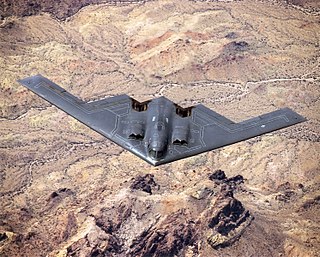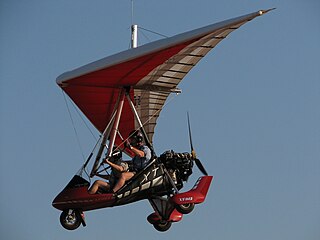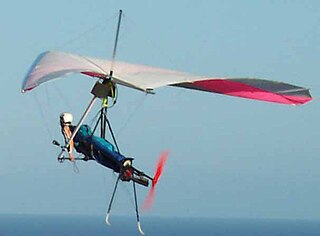
Hang gliding is an air sport or recreational activity in which a pilot flies a light, non-motorised, fixed-wing heavier-than-air aircraft called a hang glider. Most modern hang gliders are made of an aluminium alloy or composite frame covered with synthetic sailcloth to form a wing. Typically the pilot is in a harness suspended from the airframe, and controls the aircraft by shifting body weight in opposition to a control frame.

The Gossamer Albatross is a human-powered aircraft built by American aeronautical engineer Dr Paul B MacCready's company AeroVironment. On June 12, 1979, it completed a successful crossing of the English Channel to win the second Kremer prize worth £100,000.

Ultralight aviation is the flying of lightweight, 1- or 2-seat fixed-wing aircraft. Some countries differentiate between weight-shift control and conventional three-axis control aircraft with ailerons, elevator and rudder, calling the former "microlight" and the latter "ultralight".

A flying wing is a tailless fixed-wing aircraft that has no definite fuselage, with its crew, payload, fuel, and equipment housed inside the main wing structure. A flying wing may have various small protuberances such as pods, nacelles, blisters, booms, or vertical stabilizers.

The MacCready Gossamer Condor was the first human-powered aircraft capable of controlled and sustained flight; as such, it won the Kremer prize in 1977. Its design was led by Paul MacCready of AeroVironment, Inc.

Powered paragliding, also known as paramotoring or PPG, is a form of ultralight aviation where the pilot wears a back-pack motor which provides enough thrust to take off using a paraglider. It can be launched in still air, and on level ground, by the pilot alone—no assistance is required.

An ultralight trike or paratrike is a type of powered hang glider where flight control is by weight-shift. These aircraft have a fabric flex-wing from which is suspended a tricycle fuselage pod driven by a pusher propeller. The pod accommodates either a solo pilot, or a pilot and a single passenger. Trikes grant affordable, accessible, and exciting flying, and have been popular since the 1980s.

A foot-launched powered hang glider (FLPHG), also called powered harness, nanolight, or hangmotor, is a powered hang glider harness with a motor and propeller often in pusher configuration, although some can be found in tractor configuration. An ordinary hang glider is used for its wing and control frame, and the pilot can foot-launch from a hill or from flat ground, needing a length of about a football field to get airborne, or much less if there is an oncoming breeze and no obstacles.

The Short SB.4 Sherpa was an experimental aircraft designed and produced by the British aircraft manufacturer Short Brothers. Only a single example was ever produced.

A glider is a fixed-wing aircraft that is supported in flight by the dynamic reaction of the air against its lifting surfaces, and whose free flight does not depend on an engine. Most gliders do not have an engine, although motor-gliders have small engines for extending their flight when necessary by sustaining the altitude with some being powerful enough to take off by self-launch.

The Dunne D.5 was a British experimental aircraft built in 1910. A tailless swept-wing biplane, it was designed by J. W. Dunne and built by Short Brothers at Leysdown for his company, the Blair Atholl Aeroplane Syndicate Ltd. Like its military predecessors it was driven by twin pusher propellers, but it had a considerably more powerful engine.

A human-powered aircraft (HPA) is an aircraft belonging to the class of vehicles known as human-powered transport.
The HPA Toucan is a British two-seat human-powered aircraft built and flown by members of the Hertfordshire Pedal Aeronauts and was the first two-person human-powered aircraft to fly.
The Electricsports ES-Trike is a German electric-powered ultralight trike produced by Electricsports GmbH of Ostrach. The aircraft is supplied complete and ready-to-fly.
The Fly Air Trike Moster is a Bulgarian ultralight trike that was designed and produced by Fly Air Limited of Trudovec. The design is supplied complete and ready-to-fly.
The Goodhart Newbury Manflier was a two-place human-powered aircraft designed by Nicholas Goodhart. Its most notable feature was that the two pilots were placed in separate fuselages, spaced 70 ft apart.
The Paxton man-powered aircraft was the project of architect Tony Paxton, to create a compact human-powered aircraft, suitable for sports flying.
The HVS was a human-powered aircraft, designed and built by three German aeronautical professionals. Its name comes from the surnames of those involved; Wolfang Hütter, Franz Villinger, and Wilhelm Schüle. Villinger co-designed the 1930s HV-1 Mufli human-powered aircraft.
The Ikarus was a human-powered ornithopter, designed by the sculptor and designer Emiel Hartman in the late 1950s.
The Smolkowski-Laviolette biplane was a Canadian human-powered biplane designed and built by two Calgary aeronautical engineers, Alvin Smolkowski and Maurice Laviolette, in the 1960s.












